Delphinium—one of our most-requested plant profiles! Plant Profiles dive deep on one plant variety. They are meant to provide you with enough information to make good growing decisions. A desire to grow gorgeous flowers is one thing. However, discerning if a particular plant is right for you and your climate is a whole other ballgame.
My intention here is to give you as much practical information to make these decisions. However, I’m going one step further and taking you completely behind the scenes to share exactly what has worked for us as well. For this reason, Plant Profiles are broken up into what I’m calling the “Nuts and Bolts (N&B)” and “Behind the Scenes (BTS).”
If you haven’t already, please be sure to read the FFY Introduction to learn more about how Plant Profiles are organized.
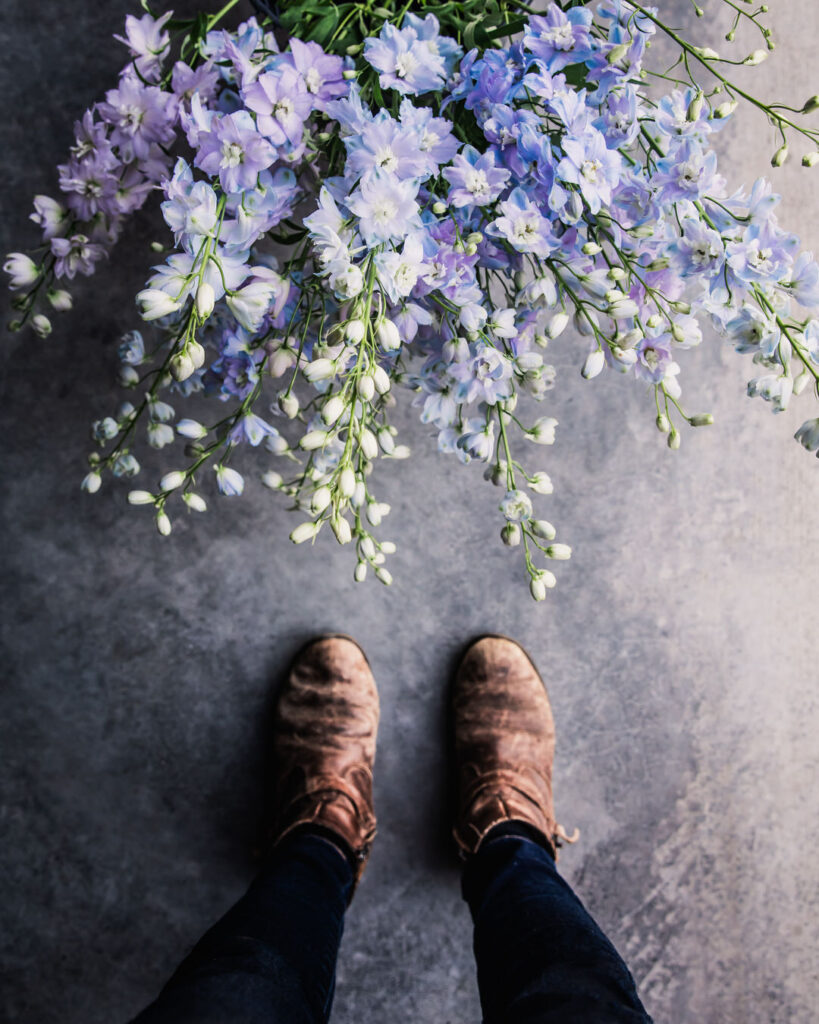
Primary Sources
The primary sources for the N&B portion come from:
- Postharvest Handling of Cut Flowers and Greens: A Practical Guide for Commercial Growers, Wholesalers & Retailers (Dole, Stamps, Carlson, et al).
- Specialty Cut Flowers, 2nd Edition, Revised & Enlarged (SCF): Industry standard for both new and experienced growers on the production of annuals, perennials, bulbs, and woody plants for fresh and dried cut flowers (Allan M. Amritage and Judy M. Laushman)
- Johnny’s Selected Seeds (Johnny’s): Johnny’s has been in the business for 50 years, with a research farm dedicated to finding the best seeds and tools for farmers and gardeners
- BOSTON Ornamental Terminal Prices. Specialty Crops Market News Federal – State Market News Service, USDA (as of 14-FEB-2023
- The Cut Flower Sourcebook: Exceptional perennials and woody plants for cutting (Rachel Siegfried).
Zone Considerations
- Johnny’s Selected Seeds research farm is located in Zone 5a Maine
- Rachel Siegfried’s farm, Green and Gorgeous, is located in South Oxfordshire
- My farm, Petal Back Farm, is located in Zone 4b Wisconsin
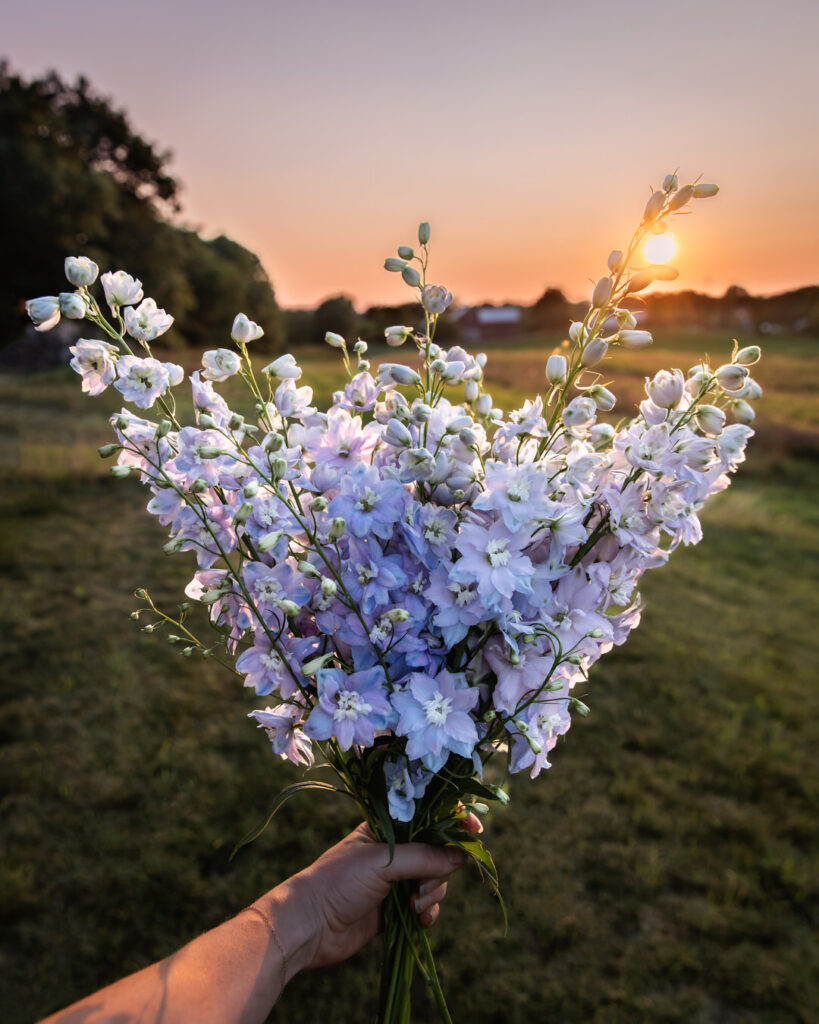
General Information: N&B
Latin Name: Delphinium spp. (we typically grow D. elatum)
Common Name: Candle Larkspur, Delphinium, Elijah’s Chariot, Lark’s Claw, Lark’s Heel, Larkspur
Symbolic Meanings: Ability to transcend the bounds of space and time; Airy; An open heart; Ardent attachment; Big-hearted; Fickleness; Fun; Heavenly; Hilarity; Levity; Lightness
Possible Powers: Drive away scorpions; Lightness; Swiftness
Origin: Native to the Northern Hemisphere, primarily found in mountainous regions of Europe, Asia, and North America
Days to Maturity: 105–125 days
Life Cycle: Short-lived perennial, Zones 3–7 (often treated as annual in cut-flower production)
Spacing: 12–18″ if being grown as a perennial. 9–12″ apart if being grown as an annual.
Height: 36–48″
Delphinium has a rich history. The Delphinium genus derives it’s name from the Greek word “delphinion”, meaning “dolphin,” due to the shape of its flower’s spur. In ancient Greece, the flower symbolized grace and spirituality. Delphinium became one of the most sought-after cut flowers in the late 19th and early 20th centuries, due to its tall stems, graceful form, stunning colors, and long vase life. While Delphinium has a history of medicinal use, all parts of the plant are considered toxic (especially in high doses or to livestock).
There are two main forms traditionally found in the cut-flower trade. Elatum hybrids are generally double-flowered and densely flowered, while Belladonna hybrids are usually single to semi-double flowered, looser, and more open (SCF).
While the names delphinium and larkspur (Consolida spp,) are often used interchangeably by consumers, it’s important to note that they really are not the same. While they are from the same family (Ranunculaceae), they are entirely separate genuses with key differences. Not only do they have differences in appearance, but they also have different life cycles (delphiniums are perennials, while consolidae are annuals).

General Information: BTS
Delphiniums are newer to me, but I have completely fallen in love with them! It appears some of you have as well, as I have gotten many requests for more information on growing this gorgeous flower. So far, I have primarily grown D. elatum, so please know that is my primary experience. I especially love Dwarf Pacific types, because they have full florets and tight internodes.
This cottage garden staple, beloved by bees and butterflies, brings fairy bouquets to life (that’s what I call our pastel market bouquets). When brides request blue, it’s highly likely they saw a picture on Pinterest designed with delphinium, and ‘Magic Fountatins Sky Blue’ is the perfect pastel blue with kisses of soft, icy lavender.
Delphinium’s tall, upright structure adds height and drama to arrangements, bouquets, and gardens, while its clusters of delicate blooms lend an airy, dimensional quality. The individual florets are perfect for smaller design work, such as corsages, crowns, and boutonnières, offering soft colors and movement to any creation.
What I love most about delphinium as a cut flower:
- Easy to grow
- Sturdy and hardy
- Add interest to bouquets and arrangements
- Florets can be used out of water in wearables
- Comes in a fabulous range of colors, including blue (and great pastels)
- Popular with customers, florists, and wedding clients
- Prolific
- Pest/deer resistant
- Excellent vase life
- High-dollar crop
But every rose has its thorn, right? Potential shortcomings:
- Very little fragrance
- Requires support
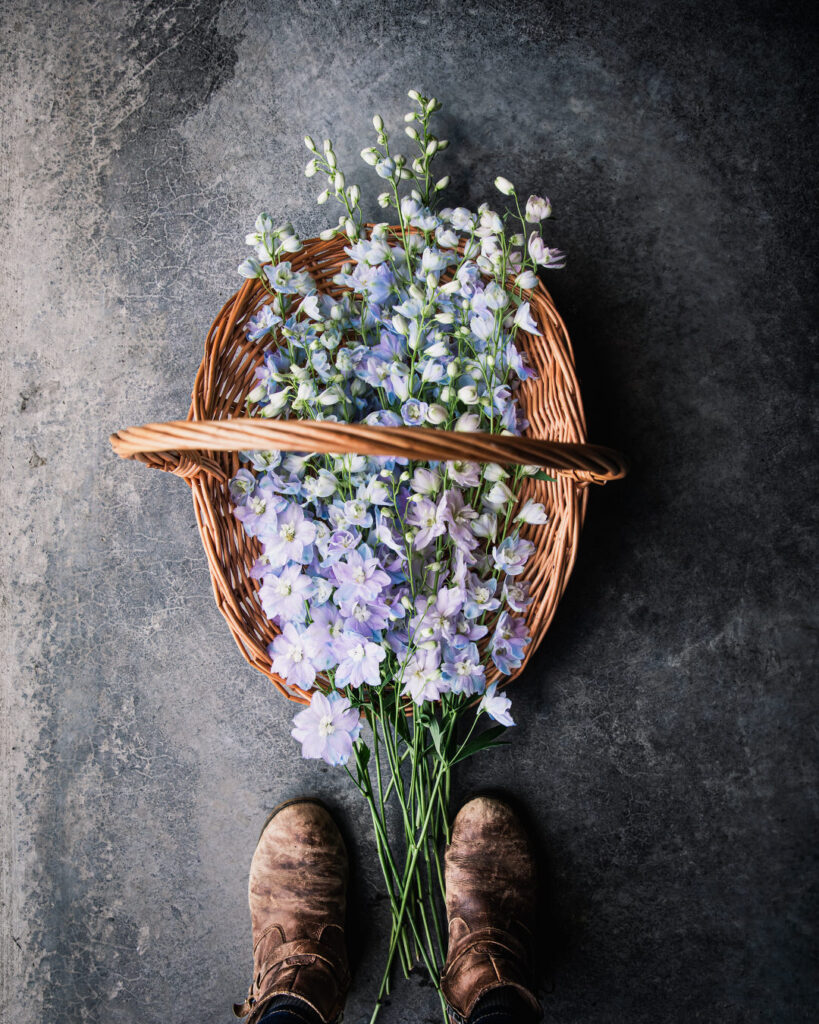
Propagation: N&B
Delphinium can be propagated by seed or basal cuttings (Siegfried). Johnny’s recommends sowing 10–16 weeks before planting out. Cover seed lightly. Days to germination: 10–20 days at 65–70F. Transplant into larger cell packs or 3–4″ containers 6–8 weeks after germination. Grow seedlings at 50–55F (18–21C).
For cuttings, take 3–4″ (8–10cm) long terminal cuttings of new shoots arising from the base of the plant. The base of the cutting should be solid, not hollow, and will root in 3–4 weeks under optimal conditions (SCF).
Propagation: BTS
Delphinium is one of the few flowers that I pot up to larger cells, and I find they really benefit from it. You can see in the photo below that the potted up delphinium becomes much stronger. Granted, the ones in the smaller tray are younger, but once they are potted up, they take off. I start them in 120-cell trays and then transplant them to 50-cell deep trays 6–8 weeks after germination. The deep cells aren’t necessary, but I have a lot of them on hand, so that’s what I use. Any larger container or cells would work. I also always keep delphinium seeds in the freezer (I find better germination this way).
Environmental Factors: N&B
In general, ideal conditions for delphinium include cool nights, temperate days, and lots of light. Plants benefit from, but do not have an absolute requirement for, cold temperatures. While not required, approximately 6 weeks at 35–40F (2–4C) will enhance flower yield and quality. For that reason, fall planting is recommended for many areas, though plants will flower first year from seed without a chilling period. Temperatures above 70F (21C) reduce flower yield and size, while night temperatures of 55–60F (13–15C) are optimum for growth. Long days hasten flowering, increase stem length, and improve quality in most delphiniums, particularly belladonna forms. High light levels in the winter are even more important than long days (SCF).
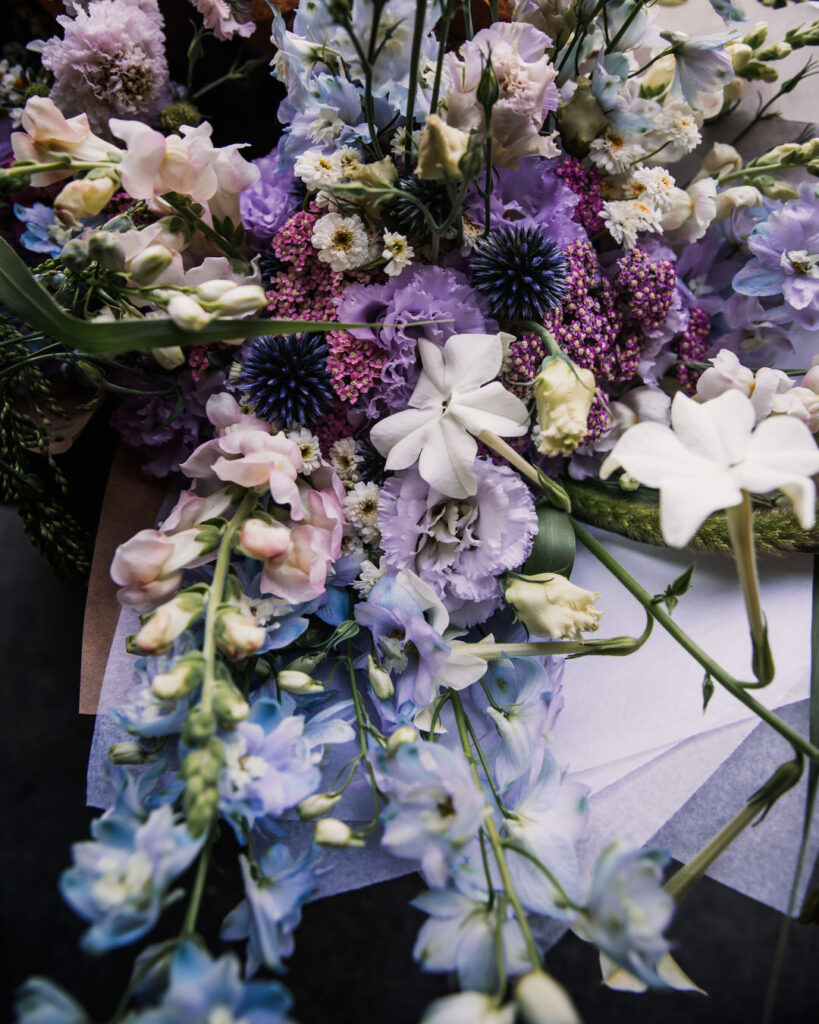
Environmental Factors: BTS
The reason delphiniums are so new to me is that I didn’t think our climate was well-suited for growing them, but they are a great lesson that many plants can adapt to less-than-ideal conditions. In my climate, our summers can get quite hot (much warmer than 70F), but we still grow decent delphinium from first-year plants.
Transplanting, Spacing, Support: N&B
If treating as a perennial, transplant at 12–18″ spacing. If treating as an annual, transplant at 9–12″ spacing. All sources recommend support netting.
Transplanting, Spacing, Support: BTS
We transplant our delphinium at 9–12″ spacing (just depends what bed they’re going in). We use hortonova netting for support.
Successions: N&B
Depending on your geographical location, delphinium can be planted in successions if summers do not get too warm. Depending on the length of your growing season, first blooms can be cut back to encourage a second flush later in the season. Pinching also delays harvests.
Successions: BTS
Thus far, I’ve only grown one succession in our high tunnel (treated as an annual). Though we tilled the bed to turn over, they have come back this spring, ha! I may leave a few to see when they flower compared to our spring-planted delphiniums. For the 2025 season, I have one succession for our high tunnel in early spring (sown in January for March/April transplant, depending on weather), another to plant in the field with the intention of perennializing (sown in February for April/May field transplant, depending on weather), and I’m planning on intentionally overwintering in our high tunnel as an experiment (July sowing for October transplant).
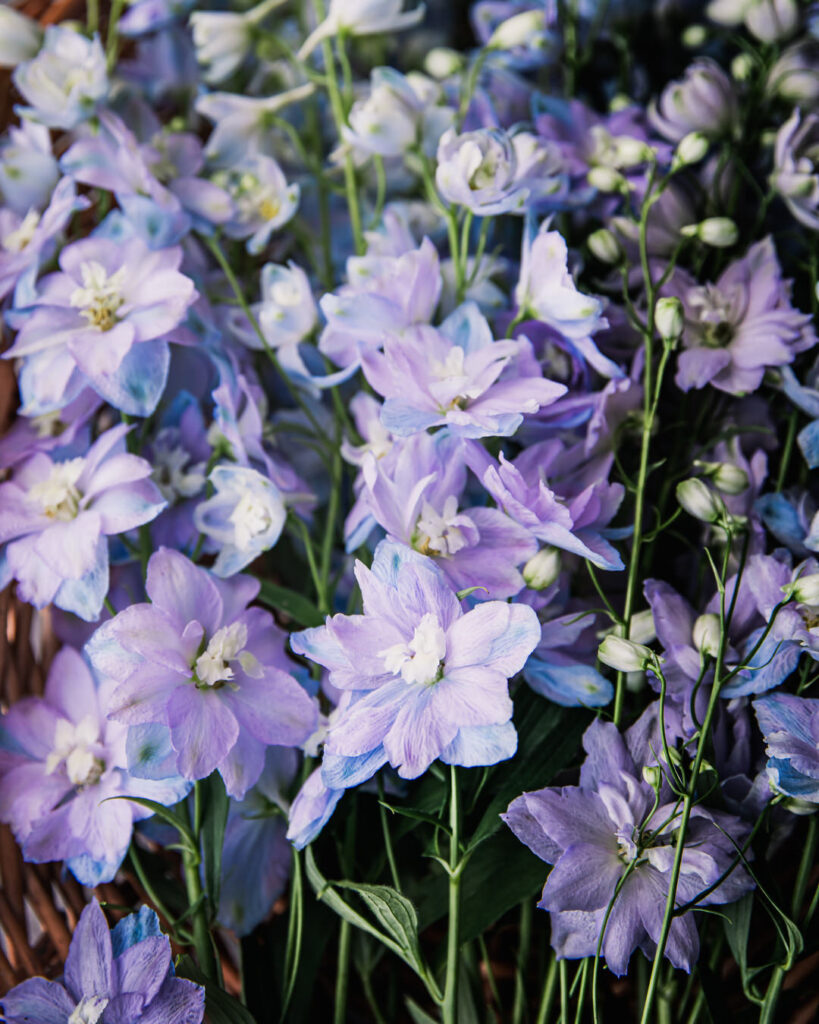
Nutrition: N&B
Delphinium prefers well-drained, fertile, slightly alkaline soil with plenty of organic matter. Fertilize lightly but frequently with a balanced fertilizer (Johnny’s) but excess nitrogen should be avoided (SCF).
Nutrition: BTS
We fertilize our fields organically based on soil tests, and we do not fertilize for each crop individually. I have an eBook that outlines exactly how we do this. I’ve made that available for you here.
Drainage & Irrigation: N&B
Delphinium prefers well-drained soil with regular irrigation. Overhead irrigation is not recommended because stems remain hollow after harvest and excess water could lead to stem rot. That said, they are a reliable perennial in field conditions, so take that for what you will.
Drainage & Irrigation: BTS
At our farm, we have gossil-loamy sand, meaning that our soil is more sand than loam. It actually drains excessively to the point of leaching nutrients. Our biggest difficulty is keep plants irrigated, especially in dry spells. For this reason, we do have drip irrigation installed on all of our beds at the home farm.
Pinching: N&B and BTS
Delphinium can be pinched but it’s also not necessary. Some studies have found that pinching increases yield, while others have not.
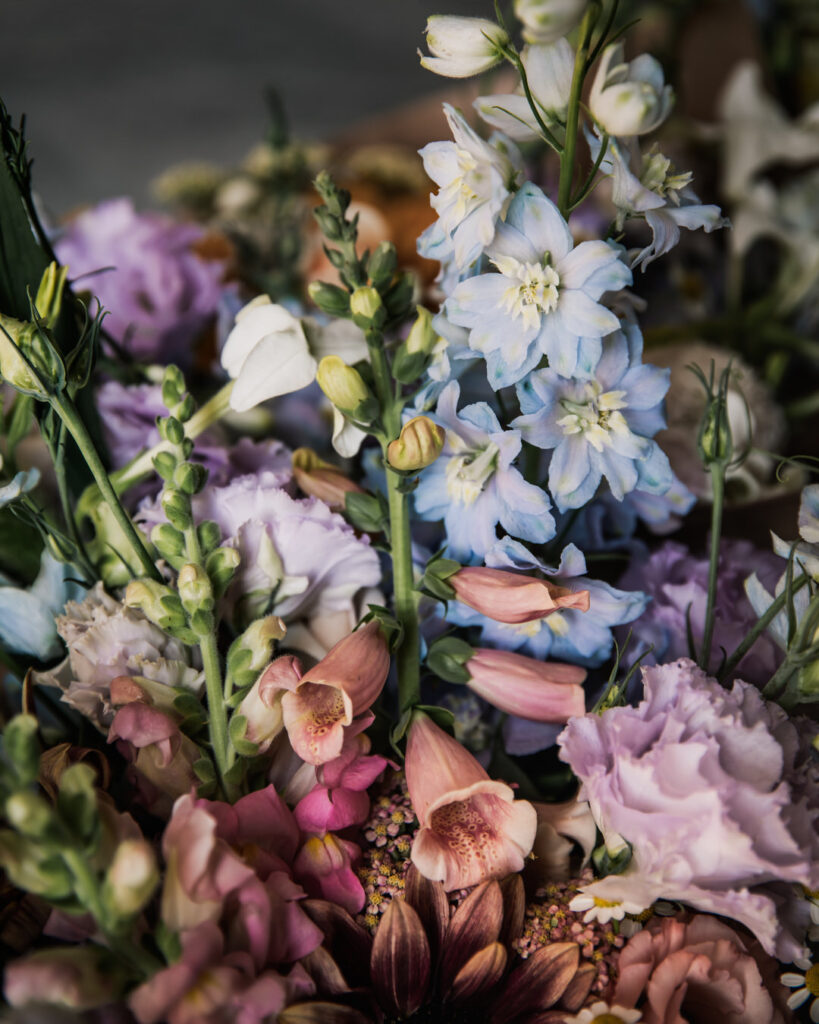
Bloom Period & Yield: N&B and BTS
Delphiniums mature in 105–125 days, typically blooming June through September depending on geographical location and heat of summer (much earlier in tunnel or greenhouse conditions). Generally, they are going to bloom in early summer and then again in the fall. We had blooms in June/July and then again the fall (I believe it was September/October, but the bed was pretty grown over). In Johnny’s overwinter trials in Zone 5 Maine, they had early May harvests from a July sowing/October transplant. Generally, elatums should yield a minimum of 4 stems per plant per year for a period of 3 years, and belladonnas 6–8 stems (though both are known for producing more).
Overwintering: N&B and BTS
Delphinium can be overwintered successfully in most areas. Johnny’s notes as low as Zone 3 and SCF notes as low as Zone 2. Johnny’s reported 80–100% survival rate overwintered in their tunnel in Zone 5 Maine. Delphinium can be successfully overwintered in my own Zone 4.
Harvest & Post-Harvest: N&B
In general, a good rule of thumb is to harvest when 1/4 to 1/3 of flowers on stem are open. Wholesale: harvest when the lower 1 to 2 flowers have opened. Retail: cut when 1/4 to 1/2 flowers have opened. Place immediately in water. Holding solution will increase vase life. Store upright to prevent curvature. Store 36–40F (2–4C) for 2–3 days. Expected vase life: 6–8 days in water, longer with solution (Postharvest Handling).
Plants bloom again in late summer and early fall if cut back immediately after the first bloom.
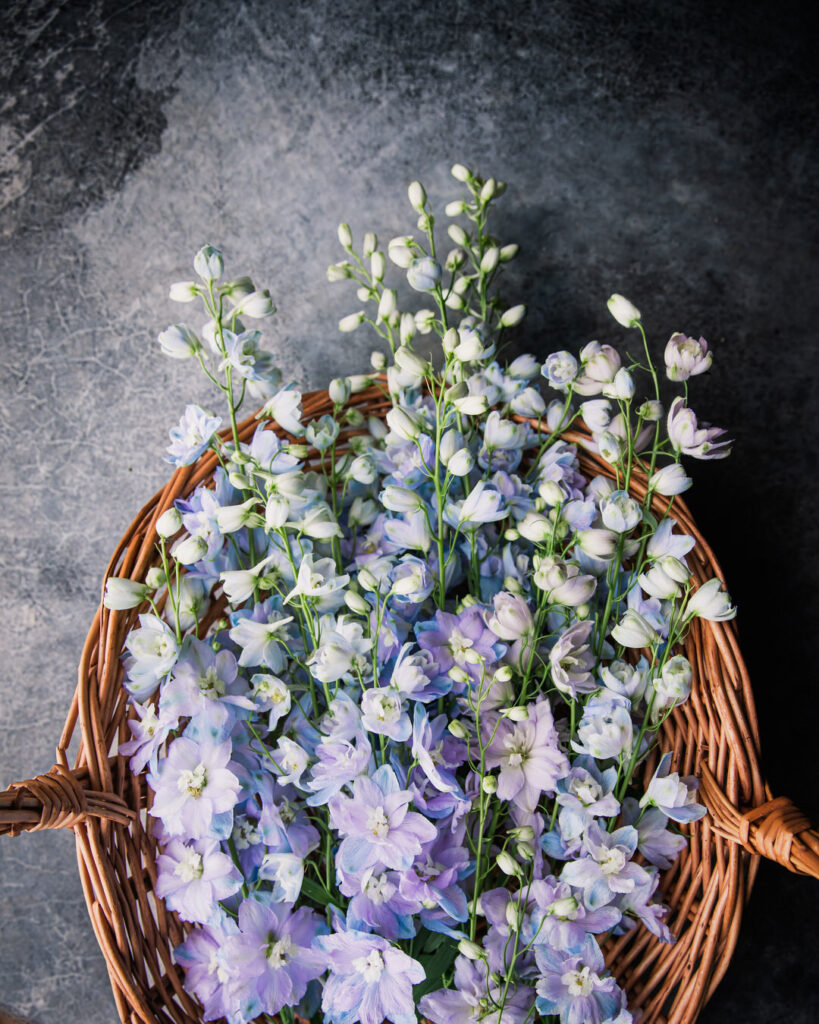
Harvest & Post-Harvest: BTS
For harvest, we stick to the general recommendations and do use holding solution in our harvest buckets.. We pick for the week and store in our cooler for a few days at most, which is usually around 38F in spring. However, I have stored delphinium longer for events, but not much more than a week.
Pests & Disease: N&B
Delphiniums are generally fuss free and pest resistant. However, some diseases include crown rot, virus, and powdery mildew. Slugs, thrips, and aphids can cause headaches with delphinium. For disease and pest control, see Johnny’s comparison chart.
Pests & Disease: BTS
So far, we have not had any major issues with delphinium.
Variety Selection: N&B and BTS
Personally, I love the Magic Fountains and Guardian series, because they have full florets and tight internodes, but a lot of flower farmers love the Belladonna series as well for their productiveness. My top favorite varieties are: Magic Fountains Sky Blue and Cherry Blossom and Guardian Lavender. We get our seeds wholesale from Johnny’s, Ball, or Ivy Garth. If you are only in need of smaller quantities, we offer seeds here, and remember that you get 20% off (SEED20)!
Pricing: N&B and BTS
BOSTON Ornamental Terminal Prices as of 26-DEC-2023:
DELPHINIUM: MARKET STEADY. per bunch EC Hybrid long 17.50 PE Hybrid long 17.50 bunched 10s EC Belladonna exlong 17.50-18.00 long 14.50
$17.50 is also my florist price. I don’t typically sell delphinium by the bunch for retail as they are most often used in our mixed bouquets and design work.
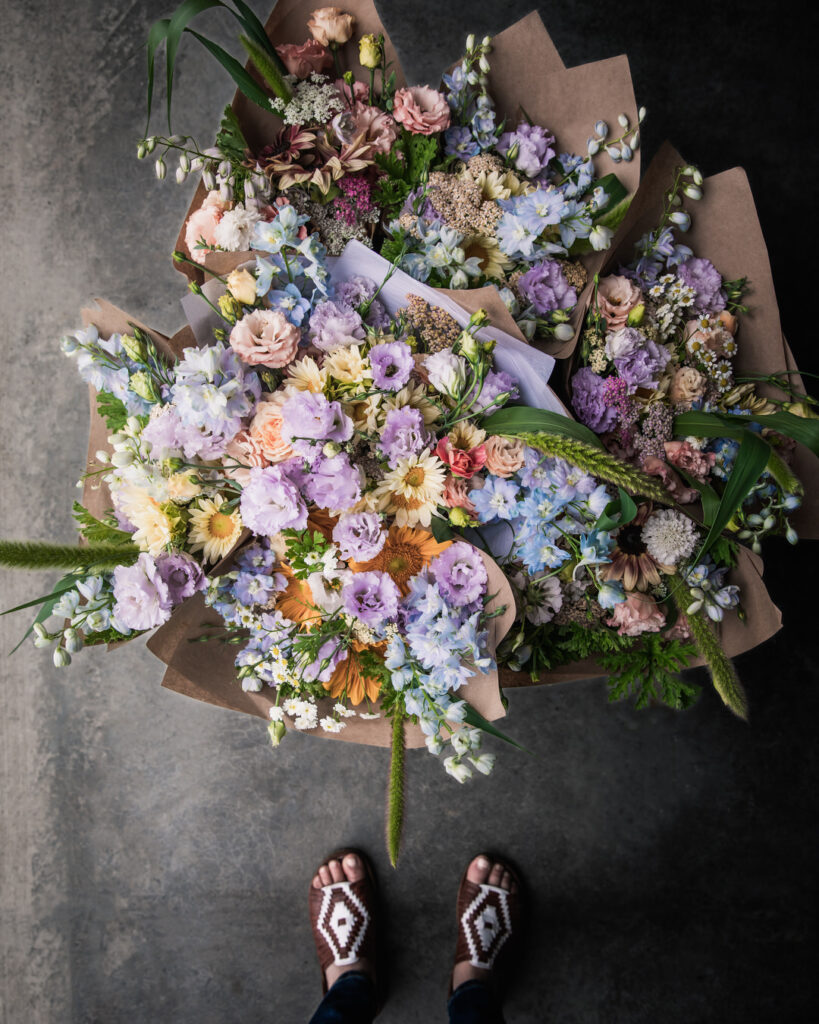
Design: BTS only
One of the reasons I love delphinium so much is because of its design versatility. Full, long stems can be used for large, dramatic arrangements. Remove lower florets for more useable stems in wrapped bouquets and bridal bouquets. Florets are also incredible for wearables. They have a long “stem” on the florets that attaches to the main stem. I keep this intact to make the florets easier to work with. Delphinium works especially well with glue.
I also adore delphinium’s perfect pastel hues and the form of the florets. They are amazing for “fairy” designs (a term I like to use for designs that are heavy with florals, usually stems with multiple, smaller florets). On our intake form for Wedding À La Carte, I ask clients for a link to their Pinterest page. If they request light blue, I can almost guarantee that Pinterest page is going to have delphinium on there🙂
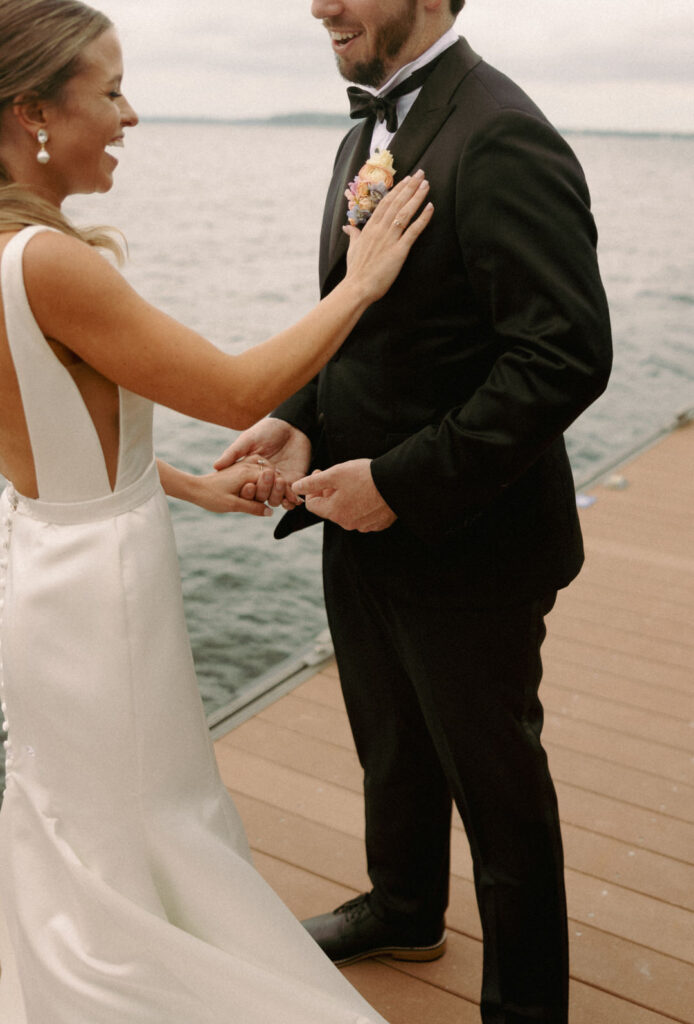

Wrap Up
OK, my friend, that is IT for this Plant Profile. What do you think? Did you find some useful nuggets? Be sure to save a PDF copy using the buttons below, so you can always refer back to it.
Have any questions or something you want to share with me or others? I know I say this ad nauseam, but I truly believe in the power of the collective and that we all have something unique and powerful to share, so please leave a question or share a comment below. We’re all better for it, and I thank you in advance!
Cheers pal!
cLICK FOR Comments +